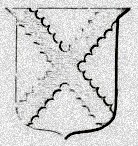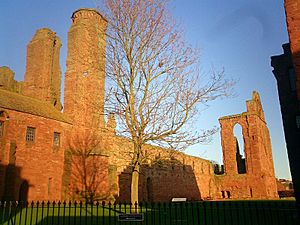Nicholas de Balmyle facts for kids
Quick facts for kids Nicholas de Balmyle |
|
|---|---|
| Bishop of Dunblane | |

The arms of the diocese of Dunblane (non-contemporary)
|
|
| Church | Roman Catholic Church |
| See | Diocese of Dunblane |
| In Office | 1307–1319 × 1320 |
| Predecessor | Nicholas |
| Successor | Roger de Balnebrich |
| Orders | |
| Consecration | 11 December 1307 |
| Personal details | |
| Born | unknown unknown |
| Died | 8 February 1319 × 30 January 1320 |
Nicholas de Balmyle (who died between 1319 and 1320) was an important Scottish leader. He was also known as Nicholas of St Andrews. He worked as an administrator and a church leader (called a prelate) in the late 1200s and early 1300s.
Nicholas went to university, but we don't know which one. He started his career as a clergyman in St Andrews. Later, he worked in churches in Lothian. He also helped two archdeacons (senior church officials) in Lothian.
In 1296, Nicholas was put in charge of the diocese of St Andrews. This happened after Bishop William Fraser died. Nicholas then played a big role in Scottish affairs. By 1301, he became the Chancellor of Scotland. This was a very important job. Even though he was quite old, Nicholas became the Bishop of Dunblane in 1307. He stayed in this position until he died.
Contents
Who Was Nicholas de Balmyle?
Nicholas was likely born in the 1230s. By 1259, he was called Magister. This means he had a Master's degree from a university. It was rare for someone so young to have this degree back then. We don't know which university he attended.
Until 1295, Nicholas was known as Nicholas of St Andrews. But in February 1295, he started being called de Balmyle. One record even called him de Balmyle but added "called de Sancto Andrea". It's thought he used "St Andrews" when he left that area. He might have dropped it when he moved back in 1295.
His last name, de Balmyle, suggests he was from Balmyle. This place is near Meigle, where Gowrie and Angus meet.
Nicholas's Early Career
Nicholas first appeared in records in 1259. He was with Gamelin, who was the Bishop of St Andrews. He didn't appear often in records for many years. But in 1268, he witnessed a document with other St Andrews churchmen. This happened at Falkland.
He then disappeared from records for a while. He reappeared as an "Official" to the Archdeacon of Lothian. An Official was someone who helped the archdeacon. This was between 1283 and 1285. He might have left Scotland to study more during this time. He probably held this job along with being a vicar (a local priest) in Haddington. He definitely held the Haddington job by 1295.
By September 1296, he was the pastor of the church of Calder Comitis in Midlothian. Both Haddington and Calder Comitis churches were connected to the Bishop of St Andrews.
In 1292, Nicholas helped John de Balliol at Berwick. This was during the "Great Cause." This was a legal process where Edward I, the King of England, decided who would be the next King of Scotland. John Balliol was chosen, but he had to obey King Edward.
Nicholas went to King John's first parliament in February 1293. This was at Scone. He witnessed other important documents in the next few years. He was still helping the Archdeacon of Lothian.
Nicholas and Scotland's Fight for Freedom
In 1296, the agreement between King Edward I and King John Balliol broke down. King Edward invaded Scotland. This started the Wars of Scottish Independence. Nicholas swore loyalty to King Edward in August 1296. His lands were given back to him.
The next year, Bishop William Fraser of St Andrews died. Nicholas was chosen to manage the diocese during this time. He did this until the new bishop, William de Lamberton, returned from France.
After Lamberton returned in 1299, he became a "Guardian of Scotland." Nicholas became his close helper. Nicholas benefited from this. By January 1301, he became the Chancellor of Scotland. This was a very powerful position. The abbey of Arbroath Abbey was supposed to pay Nicholas's salary for being Chancellor.
Later in 1301, Nicholas was one of four Scottish envoys. They were sent to Canterbury for talks with the English and French. In the next few years, Nicholas was likely involved in many diplomatic activities. He might have helped write a document for the Pope. This document argued for Scottish independence. During this time, Nicholas also became a clerk at Arbroath Abbey. He might also have become a canon (a type of priest) at Dunblane Cathedral.
Nicholas probably stayed as Chancellor until 1305. His becoming Chancellor in 1301 meant he was one of the key people. He helped lead Scotland's fight for independence.
Becoming a Bishop
After the previous Bishop of Dunblane, also named Nicholas, died, Nicholas de Balmyle was chosen. He was one of the canons (priests) of Dunblane who had to pick a new bishop. The previous bishop died sometime between 1306 and late 1307. The election was done by a small group of canons. The Abbot of Arbroath was not allowed to vote. This was because he was known to support the English.
Seven canons were chosen to elect the new bishop. They were told to choose from among themselves. They chose Nicholas de Balmyle. Nicholas, who was now the Bishop-elect of Dunblane, traveled to the Pope. After the election was approved by Pope Clement V, Nicholas was made a bishop. This happened in Poitiers on December 11, 1307.
Historians believe that Robert the Bruce, the new Scottish king, influenced this decision. Robert the Bruce likely valued Nicholas's experience. He also trusted Nicholas's political views.
Life as Bishop of Dunblane
We don't know exactly when Nicholas returned to Scotland. We also don't know much about what he did in his first few years as bishop. But because he was a bishop, he likely attended parliaments. He probably took part in kingdom affairs.
He witnessed a document for Cambuskenneth Abbey in September 1311. He witnessed many church and royal documents in 1312, 1313, and later. He witnessed royal acts in different places like Inchture, Dundee, Ayr, Edinburgh, Scone, Melrose, and Arbroath.
In October 1312, he made an agreement with the Abbot of Arbroath. This solved Nicholas's complaints about not getting his pension. It also settled other disputes between the bishopric of Dunblane and the abbey. The next year, he had a dispute with Dunfermline Abbey. This was about a church in Stirlingshire. This dispute was not solved while Nicholas was bishop.
In May 1315, he helped William de Sinclair, the Bishop of Dunkeld, make a judgment in Perth. In March 1318, he was asked by the Pope to oversee a new appointment. This was for an Italian priest at Glasgow Cathedral.
We don't know the exact date Bishop Nicholas died. The Dunblane bishopric was known to be empty by January 30, 1320. Bishop Nicholas's last appearance in records was on February 8, 1319. So, he died sometime between these two dates.




